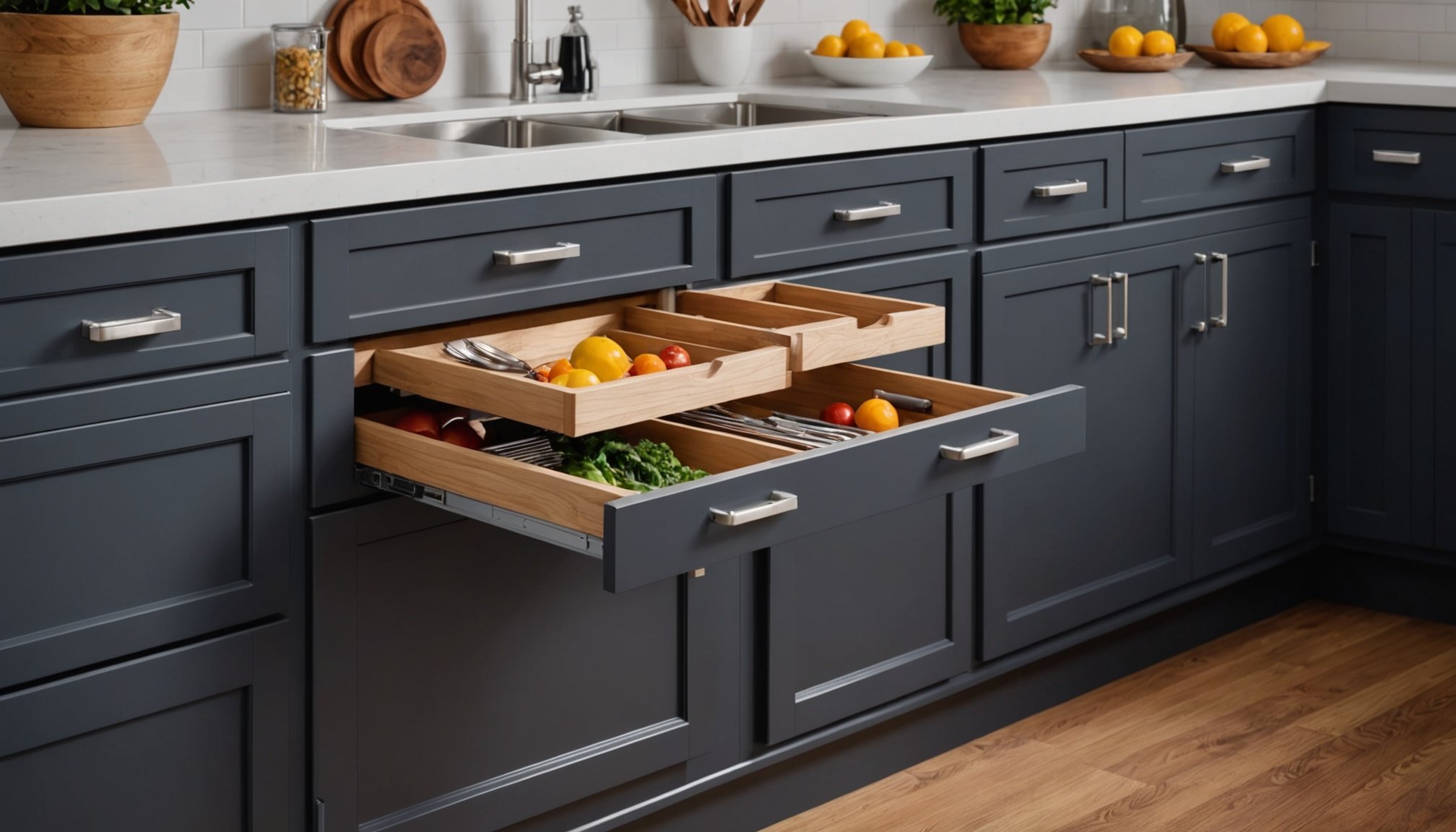Choosing the right ergonomic kitchen cabinet handles involves more than just aesthetics. Comfort and functionality play pivotal roles in your daily kitchen experience. Consider factors such as grip, size, and material to ensure the handles not only enhance your kitchen's appeal but also reduce strain during use. Prioritizing these essential features can transform your kitchen into a more efficient and enjoyable workspace. Let's explore what to look for when selecting the perfect handles for your culinary haven.
Understanding Ergonomic Kitchen Cabinet Handles
Exploring comfort and design in kitchen spaces
Also read : Exploring Space-Saving Solutions: Unique Retractable Kitchen Cabinet Doors for Compact Areas
Ergonomic kitchen cabinet handles are designed to enhance comfort and ease of use, making daily kitchen tasks more efficient. These handles are crafted with the human body's natural movements in mind, reducing strain and improving accessibility. The importance of ergonomics in kitchen design cannot be overstated, as it directly impacts the user's experience, especially during repetitive tasks like opening and closing cabinets.
Importance of Ergonomics
Why design matters in everyday use
Also read : Discover the Latest Splashback Designs That Enhance Minimalist Kitchen Styles
Incorporating ergonomic design in kitchen cabinet handles can prevent discomfort and potential injuries. Ergonomics focuses on creating products that align with the user's needs, promoting a healthier and more enjoyable kitchen environment. By reducing physical effort, these handles contribute to a smoother workflow, especially for those who spend significant time in the kitchen.
Benefits of Ergonomic Handles
Enhancing kitchen efficiency and comfort
- Reduced strain: Minimizes wrist and hand fatigue.
- Improved grip: Offers a secure hold, even with wet hands.
- Aesthetic appeal: Blends seamlessly with modern kitchen designs.
Ergonomic kitchen cabinet handles are not just about aesthetics; they provide practical benefits that enhance the overall kitchen experience. By prioritizing comfort and ergonomic design, users can enjoy a more efficient and pleasant cooking environment.
Key Features to Consider
Essential aspects for selecting the ideal handle
Importance of Grip and Comfort
Grip and comfort are crucial when selecting ergonomic kitchen cabinet handles. A well-designed handle should offer a secure hold, reducing the risk of slipping, especially with wet hands. Handles that fit naturally in the hand enhance usability and ensure comfort during repetitive tasks. This focus on grip not only improves functionality but also minimizes the potential for strain or injury.
Material Choices for Durability and Aesthetics
Choosing the right material is vital for both durability and aesthetics. High-quality materials like stainless steel, brass, or brushed nickel are popular for their resilience and modern look. These materials withstand daily wear and tear, maintaining their appearance over time. The right material complements the kitchen's design, adding to its overall appeal and ensuring long-lasting use.
Size and Shape Considerations for Functionality
The size and shape of handles significantly impact their usability. Larger handles are easier to grasp, providing better grip and comfort. The shape should align with the natural contours of the hand, promoting ease of use. Handles that are too small or awkwardly shaped can hinder functionality, making kitchen tasks more cumbersome.
- Grip: Secure and comfortable
- Material: Durable and aesthetic
- Size and Shape: Functional design
Grip and Comfort
Exploring the impact of design on user experience
Grip design plays a crucial role in enhancing the user comfort and ease of use of kitchen cabinet handles. A well-considered grip can significantly affect the overall user experience, making daily kitchen tasks more pleasant and efficient. Different grip designs offer varied benefits, catering to diverse needs and preferences.
How Grip Affects User Experience
The grip design of a handle can determine how comfortably and securely it is held. A good grip reduces the risk of slipping, particularly when hands are wet, and minimizes strain during repetitive tasks. Handles with an ergonomic grip design align with the natural hand contours, enhancing user comfort.
Different Grip Designs and Their Benefits
- Curved grips: Fit naturally into the hand, providing comfort.
- Textured grips: Offer additional friction for secure holding.
- Wide grips: Accommodate various hand sizes, ensuring ease of use.
Evaluating Comfort Based on Hand Size and Strength
When selecting handles, consider hand size and strength. Larger hands may require wider grips for better user comfort, while those with less hand strength might benefit from handles designed for ease of use. Evaluating these factors ensures that the chosen grip design meets individual needs, promoting a more comfortable kitchen environment.
Materials Used in Ergonomic Handles
Exploring options for durability and design
Common Materials for Kitchen Cabinet Handles
The choice of material is crucial for both durability and kitchen design. Common materials include stainless steel, brass, and brushed nickel. Each offers unique benefits and challenges, impacting the longevity and aesthetic appeal of the handles.
Pros and Cons of Each Material Type
- Stainless Steel: Known for its durability and resistance to corrosion. It provides a modern look but can show fingerprints easily.
- Brass: Offers a classic appeal and is also durable. However, it may require regular polishing to maintain its shine.
- Brushed Nickel: Combines durability with a soft, matte finish. It resists water spots but may not suit all kitchen designs.
How Material Choice Impacts Kitchen Aesthetics
Material choice significantly influences kitchen aesthetics. Stainless steel complements modern designs, while brass adds warmth to traditional spaces. Brushed nickel offers versatility, fitting into various styles. Selecting the right material ensures the handles not only last but also enhance the kitchen's overall look, aligning with the desired design theme. This careful consideration of material contributes to a cohesive and attractive kitchen environment.
Size and Shape Considerations
Exploring dimensions for optimal kitchen ergonomics
Ideal Dimensions for Ergonomic Handles
The size of kitchen cabinet handles is crucial for ensuring comfort and functionality. Ergonomic handles typically range from 4 to 6 inches in length, offering ample space for a firm grip. The width should allow for easy grasping without straining the fingers. Handles that are too small may lead to discomfort and reduced efficiency, while overly large handles can be cumbersome.
Shape Variations and Their Effects on Usability
Different shape variations in handles can significantly affect their usability. Rounded shapes tend to fit naturally into the palm, promoting a more comfortable grip. Conversely, angular shapes may offer a modern aesthetic but can be less forgiving on the hands. The right shape enhances kitchen ergonomics, making tasks like opening and closing cabinets more effortless.
Personalizing Handle Size for Household Needs
Personalizing the handle size and shape to fit household needs is essential. For families with children or elderly members, larger and more rounded handles are advisable to accommodate varying hand sizes and strengths. Customizing these elements ensures that the kitchen environment is inclusive and functional for all users, enhancing the overall ergonomic experience.
- Ideal Length: 4-6 inches
- Comfortable Shapes: Rounded, ergonomic
- Customization: Tailored to household needs
Aesthetic Compatibility
Exploring harmony in kitchen design
Importance of Matching Handles with Kitchen Decor
Selecting kitchen cabinet handles that complement your kitchen decor is essential for creating a cohesive and stylish environment. The right handles can seamlessly integrate with existing elements, enhancing the overall aesthetic appeal. Ensuring that handles align with the kitchen decor not only boosts visual harmony but also reflects personal style preferences.
Popular Styles and Trends in Ergonomic Handles
Ergonomic handles are available in various styles to suit different kitchen decor themes. Popular trends include sleek, minimalist designs that emphasize simplicity and functionality. For a more classic look, ornate and vintage-inspired handles can add a touch of elegance. Contemporary styles often feature bold shapes and finishes, aligning with modern kitchen decor trends.
- Minimalist: Clean lines, understated elegance
- Vintage: Ornate details, timeless charm
- Contemporary: Bold shapes, innovative materials
Tips for Selecting Handles That Enhance Overall Kitchen Design
When choosing handles, consider the existing kitchen decor and how new additions will integrate. Opt for finishes that complement other fixtures, such as faucets and appliances. Mixing metals can add interest, but maintaining a consistent style ensures cohesion. Prioritize handles that not only match the kitchen decor but also meet functional needs, balancing aesthetics with practicality.
Ease of Installation
Exploring the simplicity of fitting ergonomic handles
Overview of Installation Methods
Installing ergonomic kitchen cabinet handles can be a straightforward DIY task. The installation process typically involves aligning the handle with pre-drilled holes, securing it with screws, and ensuring a tight fit. For those without pre-drilled holes, measuring and marking the correct spots is crucial. This ensures that the handles are level and evenly spaced, enhancing both functionality and aesthetics.
Tools Needed for Installation
To facilitate a smooth installation process, gather essential tools such as a drill, screwdriver, measuring tape, and a level. These tools help in achieving precise handle fitting and ensure that the handles are securely attached. Having the right tools on hand can significantly ease the DIY installation, making it more efficient and less time-consuming.
Tips for a Smooth DIY Installation Process
- Measure twice, drill once: Accurate measurements prevent misalignment.
- Check alignment: Use a level to ensure handles are straight.
- Secure screws tightly: Prevents handles from loosening over time.
By following these tips, the installation process becomes more manageable, allowing even novice DIY enthusiasts to achieve professional-looking results. A well-executed handle fitting not only improves kitchen functionality but also enhances its aesthetic appeal.
Durability and Maintenance
Ensuring longevity and optimal performance
Factors Affecting Handle Durability
The durability of kitchen cabinet handles is influenced by several factors, including the material and frequency of use. High-quality materials like stainless steel and brass are known for their resilience, while others may wear out faster under constant use. Environmental conditions, such as humidity, can also impact their longevity.
Maintenance Tips for Keeping Handles in Good Condition
Regular maintenance is essential to preserve the appearance and functionality of your handles. To maintain durability, clean handles with a soft cloth and mild detergent. Avoid abrasive cleaners that can damage the finish. Regularly check and tighten screws to ensure the handles remain secure.
- Clean regularly: Use gentle products.
- Avoid abrasives: Protect the finish.
- Tighten screws: Prevent loosening.
Comparing Longevity of Different Materials
Different materials offer varying degrees of longevity. Stainless steel handles typically last longer due to their resistance to rust and corrosion. Brass, while durable, may require more frequent polishing. Brushed nickel provides a balance between aesthetics and durability, resisting water spots and fingerprints effectively. Choosing the right material ensures that handles not only look good but also withstand daily wear and tear, maintaining their longevity.
Visual Comparisons and Recommendations
Exploring ergonomic handle designs through imagery and expert insights
Images of Various Ergonomic Handle Designs
Visual aids can significantly enhance your understanding of handle comparisons. By examining images of different ergonomic handle designs, you can identify which styles and features align with your kitchen's needs. These images highlight variations in shape, size, and material, providing a comprehensive view of what each design offers in terms of comfort and aesthetic appeal.
Side-by-Side Comparisons of Different Styles and Features
A thorough comparison of ergonomic handles can help you make informed decisions. Consider the following attributes:
- Curved vs. angular: Curved designs offer natural comfort, while angular styles provide a modern look.
- Textured vs. smooth: Textured handles enhance grip, whereas smooth finishes emphasize sleek aesthetics.
- Material resilience: Stainless steel for durability, brass for classic appeal, brushed nickel for versatility.
Expert Recommendations for Top Ergonomic Handles on the Market
Experts suggest prioritizing handles that balance functionality and style. Here are some top picks:
- Brushed nickel: Ideal for its blend of durability and elegance.
- Stainless steel: Recommended for high-traffic kitchens due to its robust nature.
- Brass: Perfect for adding warmth and character.
These expert recommendations ensure your choice of ergonomic handles meets both practical and design expectations.











